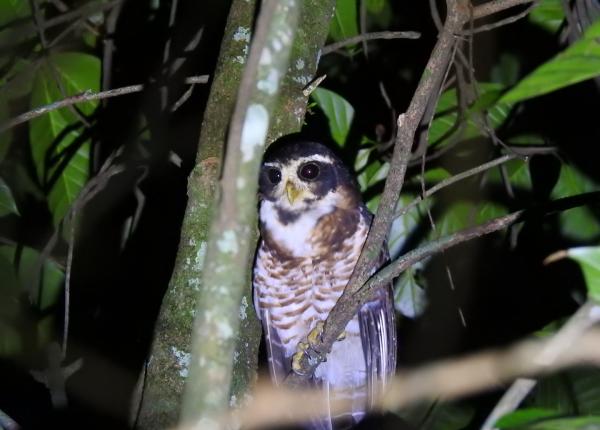How The Peregrine Fund is Helping
Though The Peregrine Fund does not work directly with Band-Bellied Owls, our efforts in scientific research, habitat conservation, education, and community development help conserve raptors around the world. We also supply literature to researchers from our avian research library, which helps scientists the world over gather and share important information on raptor conservation. Additionally, we support the Neotropical Raptor Network that helps support raptor conservation in the neotropics by fostering communication and collaboration among biologists and conservationists in the region.
Where They Live
The Band-bellied Owl is found in the tropical montane forests, woodlands, and forest edges in a relatively small area of South America. It is found in parts of the following countries: Bolivia, Colombia, Ecuador and Peru. In June 2020, it was observed in an area of eastern Colombia, where it had not been documented before.
What They Do
The appropriately-named Band-bellied Owl has rufous-colored bars running horizontally across its belly. It has white "eyebrows" and a dark eyes. Like all owls, this species has a facial disc. The facial disc is composed of many feathers around its head and helps direct sound to its ears. To get an idea of how it works, cup your hands behind your ears and listen – sounds will be louder and clearer. Owls can raise these feathers slightly when on the hunt, allowing them to hear the rustle of a mouse in the grass, the flapping of feathers in the night, or the slithering of a snake on a tree branch. These sounds give away the location of prey animals, making it easy for these owls to deftly swoop in to catch a meal.
The Band-bellied Owl is nocturnal.
Why They Need our Help
This species is classified as Least Concern. But, because so little known about this species, it is possible it is facing threats or its population is in decline, and scientists don't even know about it.
What They Eat
Believe it or not, no one really knows what these owls eat. They know that at least one individual had been feeding on grasshoppers and beetles, but that is all the information we have.
Nests, Eggs, and Young
There isn't any documented information about where or when the Band-Bellied Owl nests. It is likely that they nest in tree cavities, like many owl species do. However, scientists have yet to confirm this. We also don't know how many eggs they lay, if both adults incubate the eggs, how old the young are when they fly for the first time or anything else!
Band-bellied Owl and the World Center for Birds of Prey
The World Center for Birds of Prey offers fun ways to learn about birds of prey. Interactive activities, tours, interesting videos and a children's room with activities from coloring sheets to quizzes to costumes await you. At our visitor center, you can see live owls up close, including an Eastern and Western Screech-Owls, a Verreaux's Eagle-Owl, and an Eurasian Eagle-Owl. Come learn about the wonderful and interesting adaptations they have in order to survive in their respective habitats. There is also a touch table with owl feathers and other natural objects available for exploration.
References:
BirdLife International. 2018. Pulsatrix melanota. The IUCN Red List of Threatened Species 2018: e.T22689183A130161594. https://dx.doi.org/10.2305/IUCN.UK.2018-2.RLTS.T22689183A130161594.en. Downloaded on 31 August 2021.
Holt, D. W., R. Berkley, C. Deppe, P. L. Enríquez, J. L. Petersen, J. L. Rangel Salazar, K. P. Segars, K. L. Wood, E. de Juana, and J. S. Marks (2020). Band-bellied Owl (Pulsatrix melanota), version 1.0. In Birds of the World (J. del Hoyo, A. Elliott, J. Sargatal, D. A. Christie, and E. de Juana, Editors). Cornell Lab of Ornithology, Ithaca, NY, USA. https://doi.org/10.2173/bow.babowl1.01
Quintero, E.F.Q., N. Otero, E. Torres, F. Á, López and S. Chaparro-Herrera. 2020. Distribution and new locations for two species of owl in eastern colombia: Band-bellied Owl (pulsatrix melanota) and Rufescent Screech Owl (megascops ingens). Spizaetus: Neotropical Raptor Network Newsletter. Issue 30. pp 6-11.









